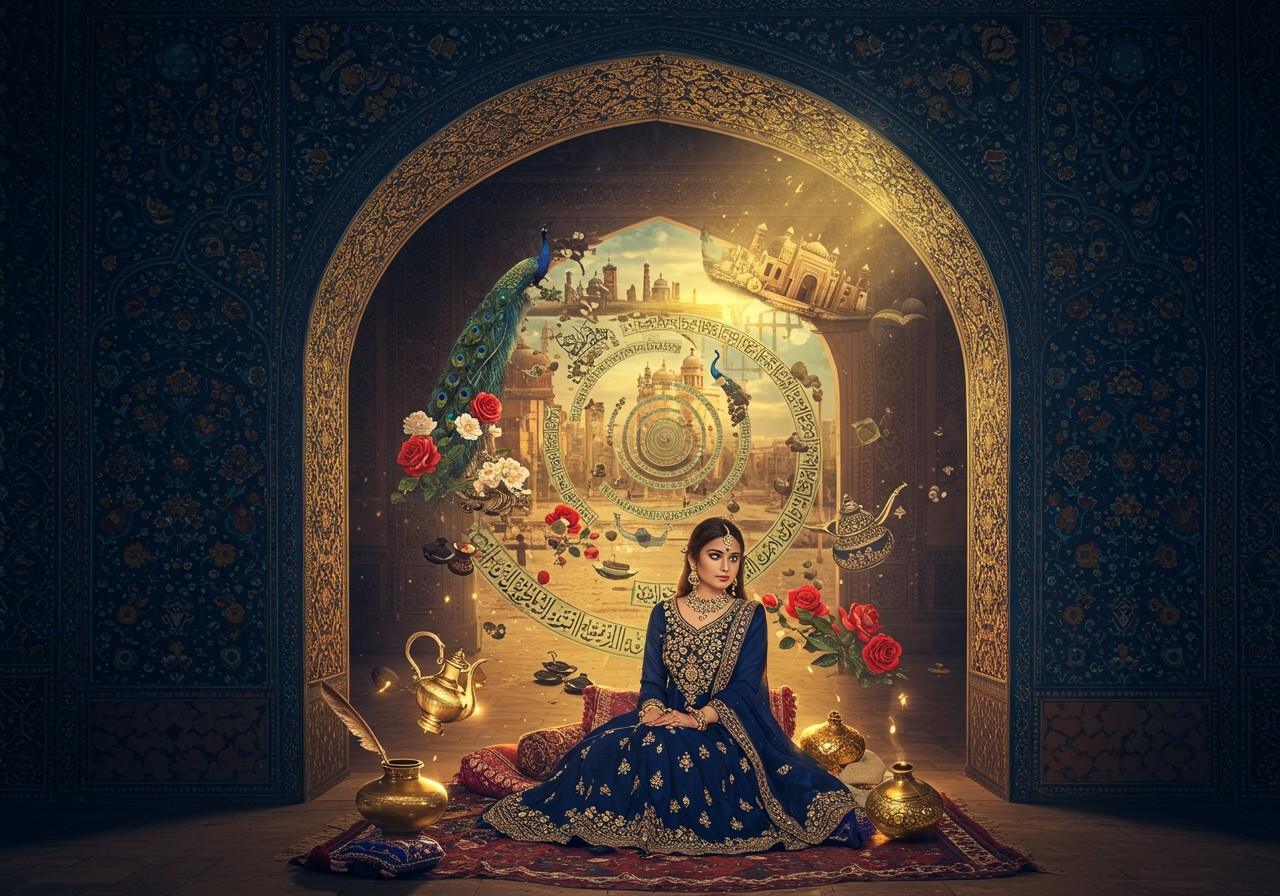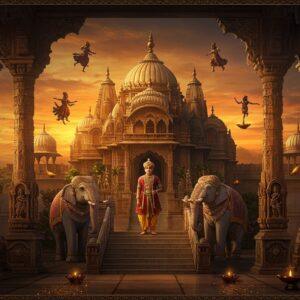
The Urdu language, a harmonious blend of history and culture, has woven together diverse traditions, creating a rich tapestry that resonates with many in South Asia and beyond. Its poetic charm and expressive depth make it a significant part of cultural identity for countless individuals.
Origins and Early Influences
Understanding the Roots
Urdu’s origins trace back to the early medieval period (between the 6th and 13th centuries), evolving from interactions between Arabic, Persian, Turkish, and North Indian dialects, particularly around Delhi, where Khari Boli Hindi was spoken. This linguistic fusion occurred during the Delhi Sultanate (1206-1526) and Mughal Empire (1526-1857), providing the socio-political context for Urdu’s emergence.
- Linguistic Influences: Arabic, Persian, and Turkish languages significantly shaped Urdu’s vocabulary and structure, while Sanskrit and Prakrit also contributed to its development. These influences blended to create a language both unique and reflective of its diverse origins.
- Historical Context: The Delhi Sultanate and Mughal Empire played a crucial role in Urdu’s development. The Delhi Sultanate’s establishment of Persian as the official language further solidified its influence on Urdu. The Mughals, known for their patronage of arts and literature, embraced Urdu as a language of administration and culture, leading to its growth and refinement.
- Key Term – Hindustani: ‘Hindustani’ was an early form of the language encompassing both Hindi and Urdu. This common language served as a foundation from which both modern Hindi and Urdu evolved, showcasing their shared linguistic heritage.
Formation and Development
Urdu flourished during the Mughal era, a period of vibrant cultural exchange. The Mughals, renowned for their appreciation of art and literature, adopted Urdu in their royal courts, further elevating its status.
The Mughal Influence
- Role in Royal Courts: Urdu became integral to the Mughal administration and cultural life, used for official communication, record-keeping, and literary pursuits. This royal patronage played a crucial role in establishing Urdu as a prestigious language.
- Cultural Patronage: The Mughals supported poets, writers, and scholars who used Urdu, fostering a flourishing literary scene. This patronage contributed significantly to the development of Urdu literature and its refinement as a language of artistic expression.
Sufi Saints and Popularization
Sufi saints played a vital role in disseminating Urdu among the masses. Their devotional poetry and music, composed in Urdu, resonated with people from all walks of life, making it a shared cultural treasure.
- Poetry and Music: Sufi compositions in Urdu touched hearts and transcended social barriers, fostering a sense of unity and shared identity. The emotional depth and spiritual resonance of Sufi poetry helped popularize Urdu among diverse communities.
- Universal Appeal: The Sufi movement’s inclusive nature made Urdu accessible to people of different backgrounds and social strata, contributing to its widespread adoption. This universal appeal helped establish Urdu as a language of the people, fostering cultural cohesion and understanding.
Urdu Literature’s Golden Era (18th and 19th Centuries)
Urdu literature experienced a golden age during the 18th and 19th centuries, with renowned poets like Mir Taqi Mir and Mirza Ghalib creating timeless masterpieces.
- Mir Taqi Mir (1723-1810): Revered as the ‘God of Poetry,’ Mir’s work is celebrated for its emotional depth and poignant portrayal of human experiences. His ghazals continue to inspire and captivate readers with their profound insights into love, loss, and the human condition.
- Mirza Ghalib (1797-1869): Ghalib’s poetry is renowned for its wit, philosophical reflections, and complex wordplay. His verses explore themes of love, life, and spirituality, offering a unique blend of intellectual depth and artistic brilliance.
Evolution in the Colonial Era and Beyond
The British colonial period brought significant changes, including the introduction of printing technology, which expanded Urdu’s reach. Urdu newspapers and literature became more accessible, further solidifying its presence.
British Influence (1837 onwards)
- Official Language: In 1837, Urdu replaced Persian as the official language of the British East India Company, marking a significant shift in administrative and legal communication. This official recognition further solidified Urdu’s position as a prominent language in the region.
- Print Media: Printing technology revolutionized Urdu’s dissemination, making newspapers, books, and other literary works more widely available. This increased accessibility contributed to the growth of literacy and the spread of Urdu across different communities.
Post-Independence and Modern Urdu (1947-Present)
Following the partition of India and Pakistan in 1947, Urdu became the national language of Pakistan and continued to thrive as a recognized language in India.
Contemporary Status
- Media and Cinema: Urdu remains a prominent language in media, cinema, and digital platforms, reflecting its continued cultural relevance. Its use in popular culture ensures its accessibility and appeal to a wide audience.
- Cultural Bridge: Urdu serves as a cultural bridge, facilitating communication and understanding between different communities in South Asia and beyond. Its shared history and literary heritage connect people across borders and linguistic divides.
Cultural Significance and Literary Richness
Urdu’s cultural impact extends beyond its linguistic boundaries. Its poetic form, the ‘ghazal,’ is celebrated for its emotional depth and lyrical beauty.
Literary Contributions
- Ghazal Poetry: The ghazal, a poetic form with a rich tradition in Urdu literature, is known for its lyrical beauty and exploration of themes such as love, loss, and spirituality. This form continues to be a popular mode of expression, showcasing the artistic richness of Urdu.
- Influence in Arts: Urdu’s influence is evident in various art forms, including music, theater, and film, enriching South Asian artistic heritage. Its presence in these diverse mediums highlights its enduring cultural significance.
Poojn.in: Celebrating India’s Cultural Heritage
Poojn.in, India’s leading online store for cultural and religious goods, supports the preservation of diverse traditions. Explore our collection of items that reflect the rich cultural tapestry of India:
- Prayer beads (Mala): Discover a variety of malas used in different spiritual practices, reflecting the shared heritage of prayer and meditation across various traditions.
- Religious texts and scriptures: Explore a selection of sacred texts in multiple languages, including Sanskrit and others, representing India’s diverse linguistic and spiritual heritage.
- Traditional items for ceremonies and rituals: Find authentic items used in various ceremonies and rituals, bridging different cultural practices and preserving the richness of Indian traditions.
Visit Poojn.in today to explore our extensive collection and experience the convenience of:
- Verified authentic products: We source our products from trusted suppliers to ensure quality and authenticity.
- Detailed product descriptions: Learn about the cultural significance and proper usage of each item.
- Pan-India delivery: We deliver across India, making it easy to access cultural and religious items.
- Expert guidance: Our customer service team is available to answer your questions and provide assistance.
- Secure online shopping: Enjoy a safe and secure online shopping experience with multiple payment options.
Embracing Urdu’s Legacy
Urdu’s journey is a testament to its resilience and beauty. From the Mughal courts to the verses of Sufi poets, it has touched countless lives. Today, it continues to flourish in media, cinema, and literature, serving as a bridge between cultures. Let us cherish and preserve this timeless treasure for generations to come.
FAQs
How was Urdu formed? Urdu emerged from the fusion of native Indian languages with Persian, Arabic, and Turkish influences over centuries, particularly during the Mughal era.
How did Urdu develop? Urdu’s development involved absorbing vocabulary and grammatical elements from Persian, Arabic, and Turkish while retaining influences from Sanskrit and Prakrit. It evolved through literature, poetry, and use in royal courts.
When did Urdu originate? Urdu began taking shape around the 12th century during the Delhi Sultanate, evolving significantly under Mughal rule in the 16th and 17th centuries.
What influenced Urdu? Persian, Arabic, and Turkish languages significantly influenced Urdu due to cultural exchanges during the Mughal and Sultanate periods.
Why is Urdu written in the Persian script? Urdu adopted the Persian script due to significant Persian influence during its formation. The script was adapted to accommodate Urdu’s phonetic sounds.


